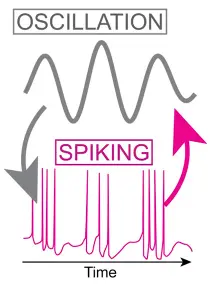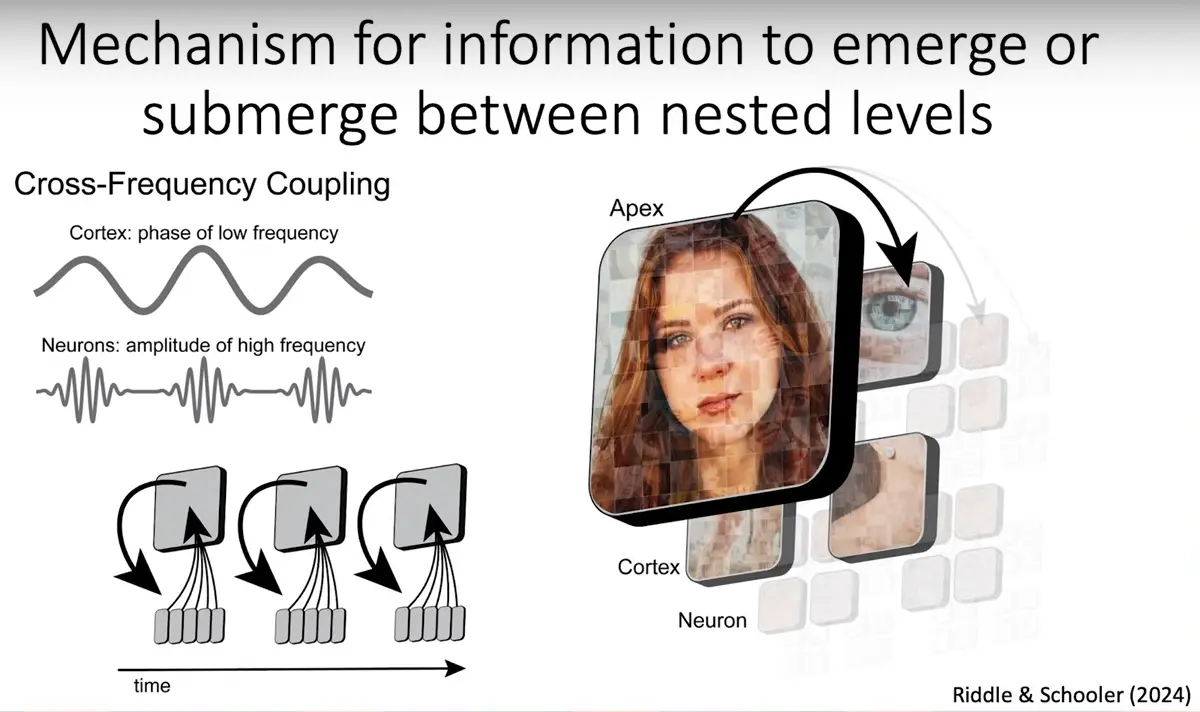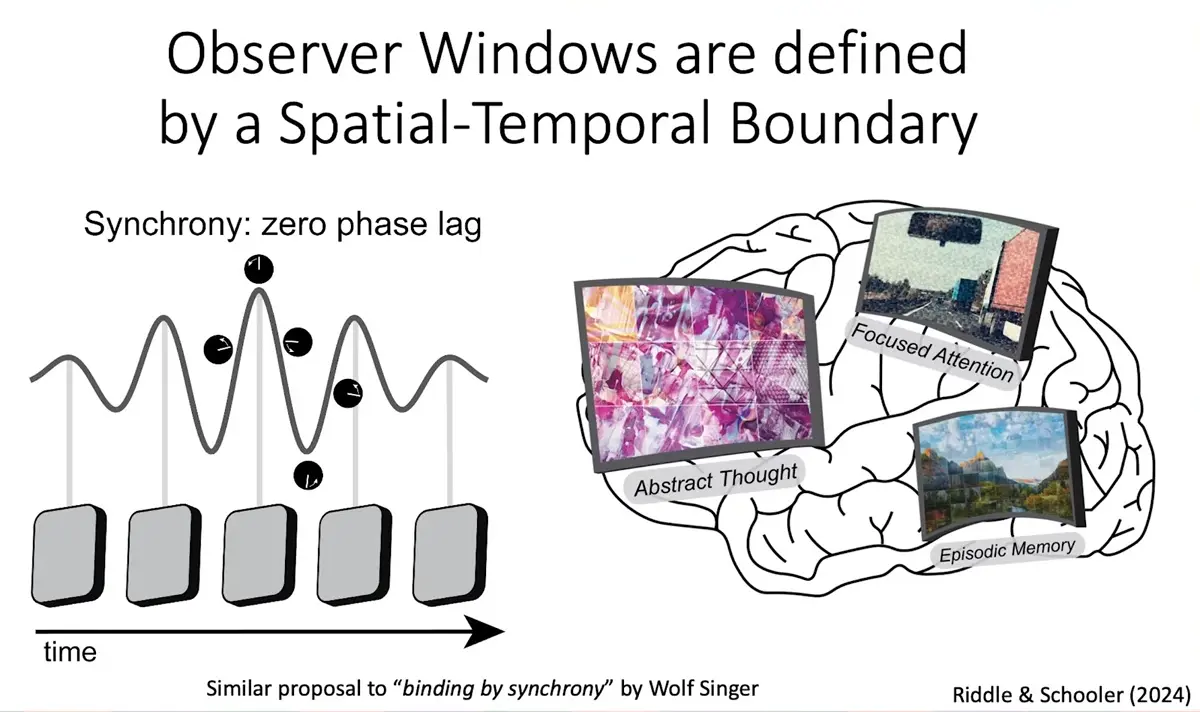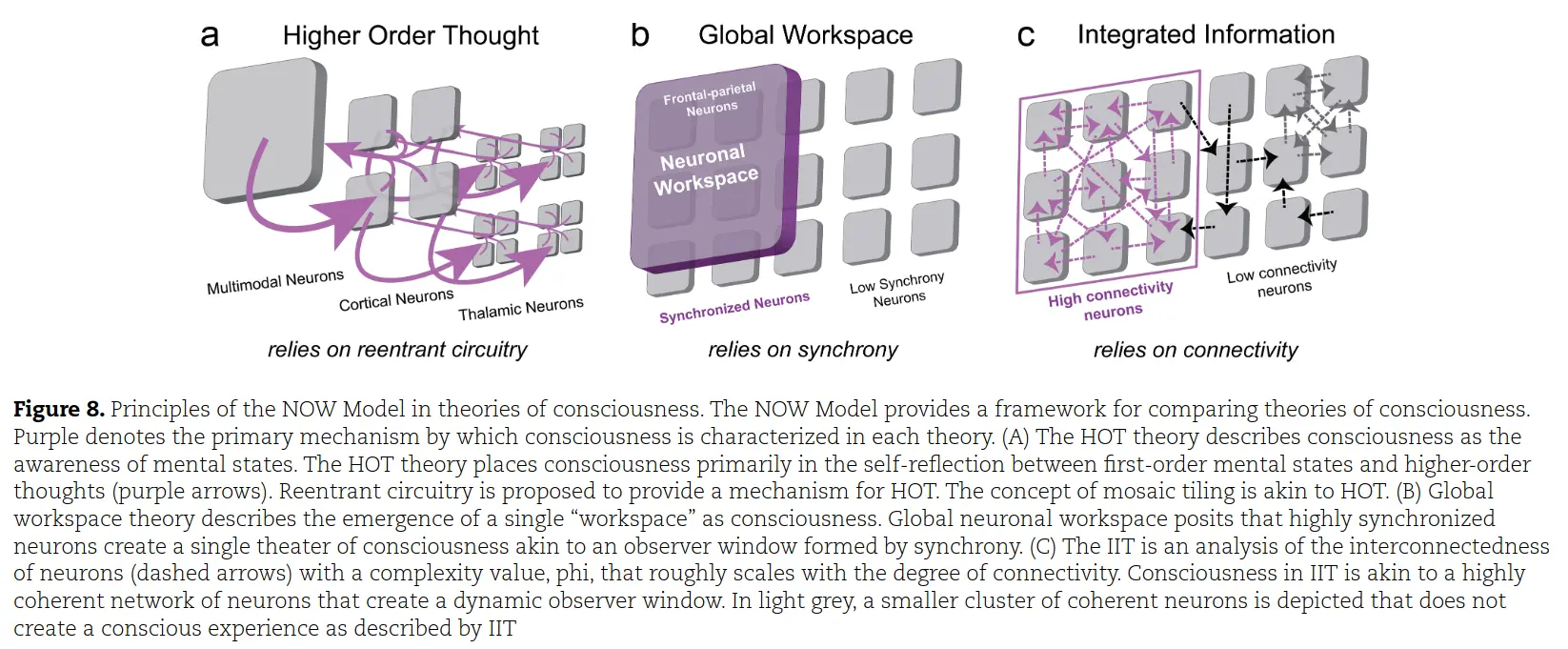year: 2024/03
paper: https://academic.oup.com/nc/article/2024/1/niae010/7631826?login=false
website: Youtube: Justin Riddle - Nested Observer Windows: the case for hierarchical consciousness
code:
connections: consciousness, brain, hierarchical, multi-scale
→ The brain and its structures are fractal and nested. There is complexity and sub-systems at every level.
→ You cannot reduce it to the sum of the parts.
In our daily lives, we are often faced with competing interests, even in our brain:
We know what it is to get out of bed on a freezing morning in a room without a fire, and how the very vital principle within us protests against the ordeal. Probably most persons have lain on certain mornings for an hour at a time unable to brace themselves to the resolve. We think how late we shall be, how the duties of the day will suffer; we say, ‘I must get up, this is ignominious,’ etc.; but still the warm couch feels too delicious, the cold outside too cruel, and resolution faints away and postpones itself again and again just as it seemed on the verge of bursting the resistance and passing over into the decisive act. – William James, Principles of Psychology
This follows in line with Bach’s conception:
Transclude of Joscha-Bach#^fa68db
There is a dialogue so to say, between different structures or interests within the brain - and this dialogue also has a conductor:
Transclude of Joscha-Bach#^52e2a9
This conductor is nothing immaterial, it is nothing fundamentally different to the other structures / assemblies of neurons working together closely. It is influenced by them in the same dialogue, sometimes it is overwriten (esp. in the case of addictions), but mostly, esp. in the healthy case, it seems to have executive power.
It’s likely that there are different channels of information being processed at different spatial and temporal scales in the brain (Network, Circuit, Neuron, Pathway, Protein, ….) with some sort of meaningful exchange across levels.
Brain oscilations for example, are not just a epiphenomenal - just a side-effect, like the steam off of the brain-train - yes, neurons create electrical fields, but these electrical fields and oscilations caused by entire populations of neurons in turn act back on their spiking behaviour.
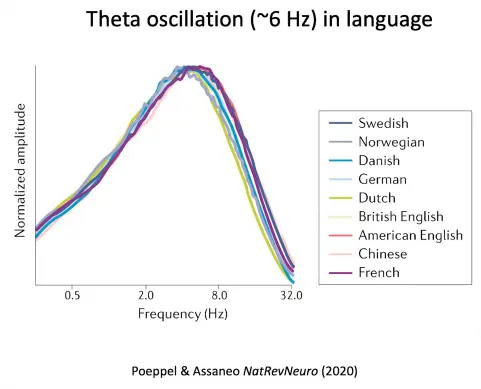
So our vision is updating at a constant “frame-rate”. We likely do not perceive this flickering, as the apex / consciousness level operates slowe than that.
The theta ryhthm has about the same frquency as the frquency with which we produce sound chunks.
If you flash a light really quickly, you’ll perceivie it as a single flash. The rate at which the visual cortex is fluctuation is correlated with the flicker-fusion rate.


“Observer Window”: Like the cognitive light cone.
“Dialogue”: Communication between “tiles” across hierarchies and at the same hierarchy.
cross-frequency coupling is a means of transferring information up and down the nested hierarchy
- emergence of information from the lower into the higher order
- submergence of information down into smaller, faster windows. “sending control signals into the sub-structures”
Everything within an observer window is perfectly synchronized. “synchrony”
“Zero phase-lag connection between all components of a system” / “zero lag synchronization”
This is what makes “a thing” act like “one thing”.
Information in different parts of the system is processed simultaneously (integrated and processed in a temporally coordinated manner).
Dialogue
A non-zero phase-lag between two systems, where one is kind of talking while the other one listens, not fully fusing into one another.
The term “dialogue” is introduced to emphasize that these are autonomous cognitive systems that are talking to eachother, rather than fusing with some direct wire connection.
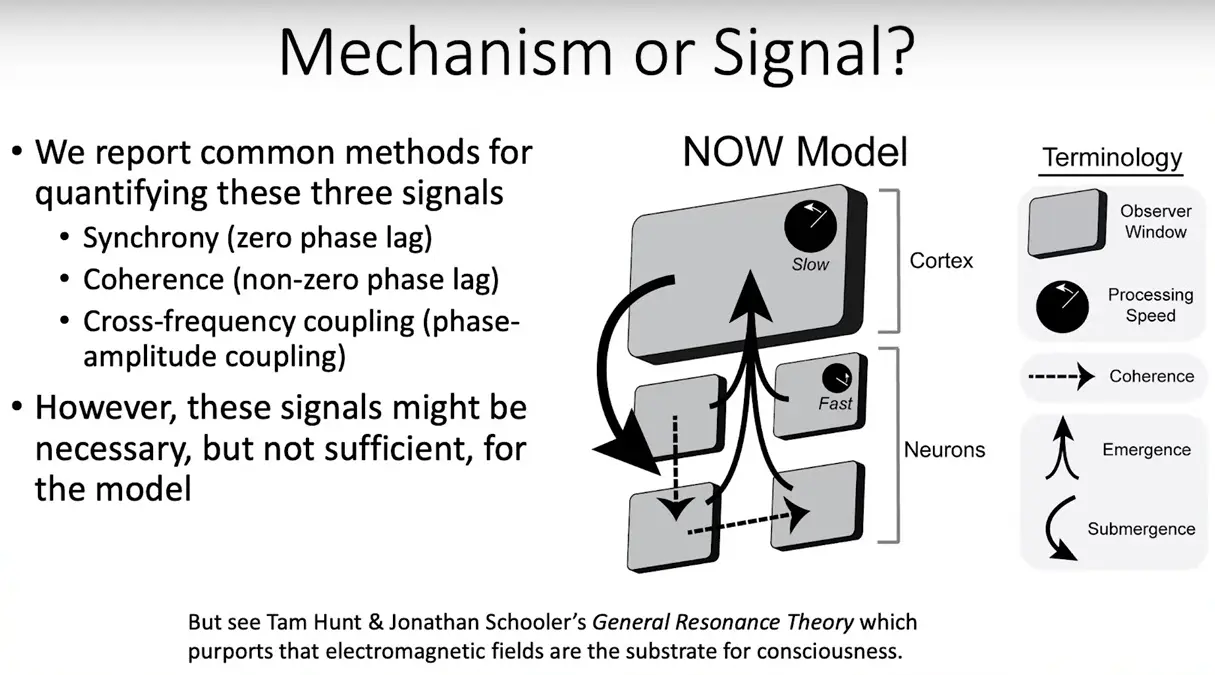
Fully formed ideas often arise spontaneously at the conscious level, emerging from the lower levels / background thinking. We plan at different time-scales and detail-scales. The “apex level” usually isn’t concerned with the motion of specific muscles etc., but rather plots high-level sketches of actions, “cartoon plans” → submergence.
This very much ties into what michael levin is saying, that all organs or cell groups are basically conscious to some degree, just that they don’t communicate with language or operate at lower levels like any other neural assembly in the brain … these cells are really no different to the cells in the rest of the body.
Self-control / discipline
You are not fully in control of these sub-systems. You are so many levels of abstraction away, that you can only steer with high-level signals (we don’t have control over optical illusions, for example if we know an image is not moving, but we still see it moving).
Though you can of course train your mind / agency / awareness to be more in control of your body, emotions, … I guess that’s what self-control really means: Having a strong conductor / general that is able to enforce order.
You are an ensemble - or rather a chaotic mess - of many different sub-processes. While you’re usually under the naive conception of “I’m me, I’m one person”, when you stop to reflect / meditate, all these conflicting selfs / sub-windows / drives / … come to surface. Learn to feel them, learn to understand them, learn to work with them, but also to assert your dominance over them.
“Evolution is selecting for slower and slower individuals” (?)
“To integrate across visual saccades or phonemes (6Hz), slow level needs to be at least ~1Hz” (?)
The apex is slow.
It integrates information from the lower levels, i.e. when you are looking somewhere, your eyes are twitching around, taking in information, which gets integrated into a scene at a higher level.
The brain needs cognitive dissonance, it needs competing narratives of experience, and of competing self to fuel motion, creativity and intelligence.
The brain is almost over-modular, and the experimental data almost doesn’t even look in the slightest to support that you are 1 person / thing only.
The most obvious: There is a huge chasm separating the left and the right hemisphere - this might be a crucial feature. Split-brain patients often have very obvious dual-personalities.
https://en.wikipedia.org/wiki/Krista_and_Tatiana_Hogan
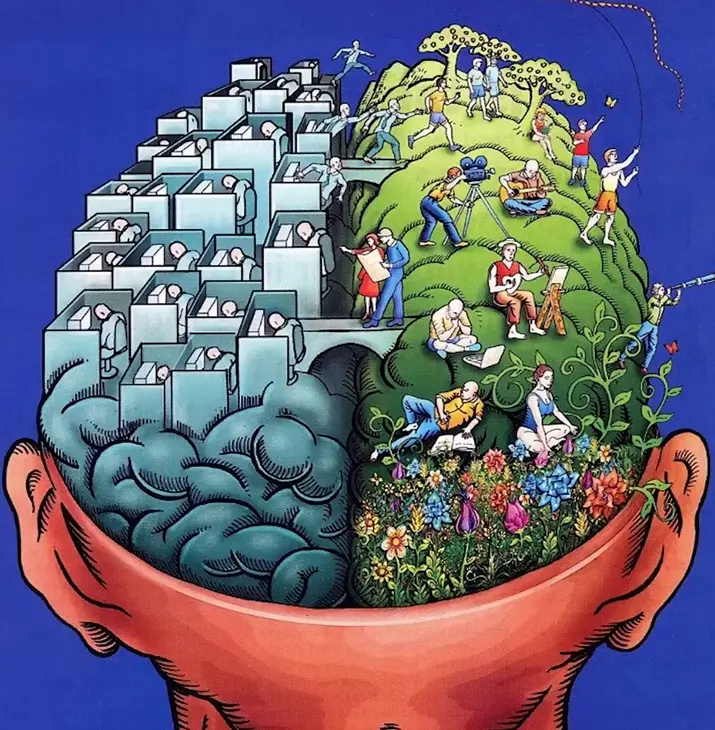
All the way down.
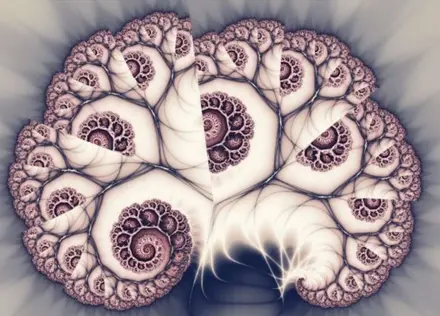
In every psychiatric disorder, there are revealing elements of truth about our conscious experience (e.g. Dissociative Identity Disorder).
We can classify into three main theories of hierarchical consciousness:
- a) “Apex hierarchical consciosness”: You exist at the Apex of the hierarchy, the only thing that is conscious in your body, you are the only one who’s home.
- b) “Emergent hierarchical consciousness”: There is a certain threshold for something to be conscious (in the sense of self-reflexive attention - as opposed to simple cognition [ (?) ok what is cognition]), but there are observer windows with independent experience - not fully independent of course, as there are tight interactions.
- c) “Panpsychic hierarchical consciousness”: Every observer window is conscious to some degree. There are still some boundaries / conditions for consciousness to be present, so it isn’t just spontaneously everyhwere, as it needs to fulfill synchrony requirements, etc. This seems to be most in line with what michael levin is saying.
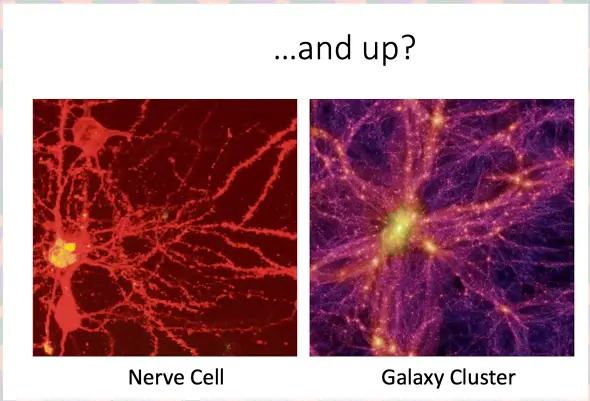
Link to originalHow do we know whether we are part of a larger cognitive system?
Probably there is some theorem that will tell us we will never know for sure, but we can gather evidence.
michael levin thinks it would feel like “synchronicity”
Convo between to neurons: (1) I feel like the environment not being stupid; almost being like it wants things from us, waves backpropagating through us that are almost like rewards and punishments. (2) Nah, you’re just seeing faces in clouds.Personally, I have an affinity for the concept discussed by Bernardo Kastrup and Rupert Spira – that we are all fragmented alters produced by a dissociative identity process from a great cosmic universal mind.
Ok no idea where his obsession with dissociative identity disorder comes from.
There is more to get from the raw paper itself, not just the video summary, e.g. the part about gwt vs IIt, … everything that is below this comment is just pasted from the paper / claude without reading it yet!
Types of Cross-Frequency Coupling
Cross-frequency coupling facilitates information transfer across spatiotemporal levels in the brain. Three main types:
Phase-amplitude coupling: The phase of a lower frequency oscillation modulates the amplitude of a higher frequency oscillation. Example: Theta phase in hippocampus modulating gamma amplitude in neocortex during memory encoding.
Phase-phase coupling: The phases of two different frequency oscillations align in a consistent manner. Example: Alpha-theta phase coupling between frontal and parietal cortices during working memory tasks.
Amplitude-amplitude coupling: The amplitudes of two different frequency oscillations covary. Example: Beta-gamma amplitude coupling in motor cortex during movement preparation.
These coupling mechanisms likely serve different functions in information processing and integration across the neural hierarchy. Phase-amplitude coupling might be particularly important for bottom-up sensory processing, while phase-phase coupling could play a role in top-down attentional control.
Two Types of Meta-Awareness
The NOW Model distinguishes two forms of meta-awareness, each with distinct mechanisms and implications:
- Propositional meta-awareness:
Awareness of specific cognitive processes occurring in nested observer windows
Requires sustained conscious effort to maintain
Mechanism: Increased top-down attention from apex to nested windows
Can be disruptive (e.g., overthinking in sports performance)
May enable improved capacity for creative higher-order thought
Absence might characterize “flow states”
- Mindful meta-awareness:
- Introspection on the apex observer window itself
- Mechanism: Recursive representation - lower-order window creates a representation of the apex, which the apex then focuses on
- Central to many meditation practices
- May lead to recognition of the fractured nature of consciousness with sustained practice
- Could explain the sense of “observing the observer” in deep meditative states
These distinctions offer a framework for understanding various states of self-reflection, from everyday introspection to profound meditative experiences, and may provide insights into the nature of self-awareness and consciousness.
Layer 1 Neurons and the Apex Observer Window
The cerebral cortex is organized into six layers, with Layer 1 being the outermost. Layer 1 has long puzzled neuroscientists due to its unique properties:
- Sparsely populated by neuron cell bodies compared to other layers
- Contains mostly dendrites and axons, forming a dense network of connections
- Exhibits widespread connectivity across different cortical areas
This widespread connectivity of Layer 1 has been dubbed the “crowning mystery” of neuroscience, as its functional role remained unclear. The NOW model proposes a potential solution:
- Layer 1 might provide the architectural basis for the apex observer window
- Its widespread connections could allow for integration of information across diverse cortical areas
- The sparse population of neurons might enable slower, more global processing characteristic of the apex
This hypothesis could explain why Layer 1 seems overdesigned for local processing - it might be optimized for global integration at the apex of the consciousness hierarchy.
